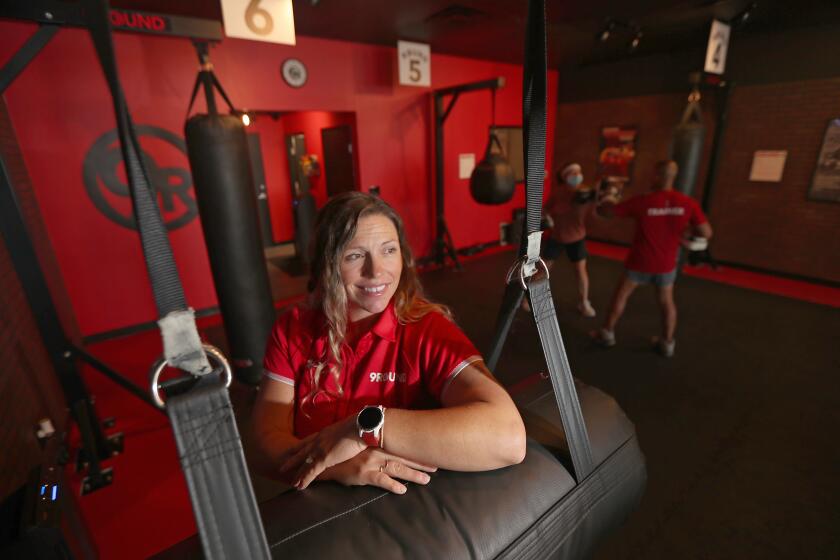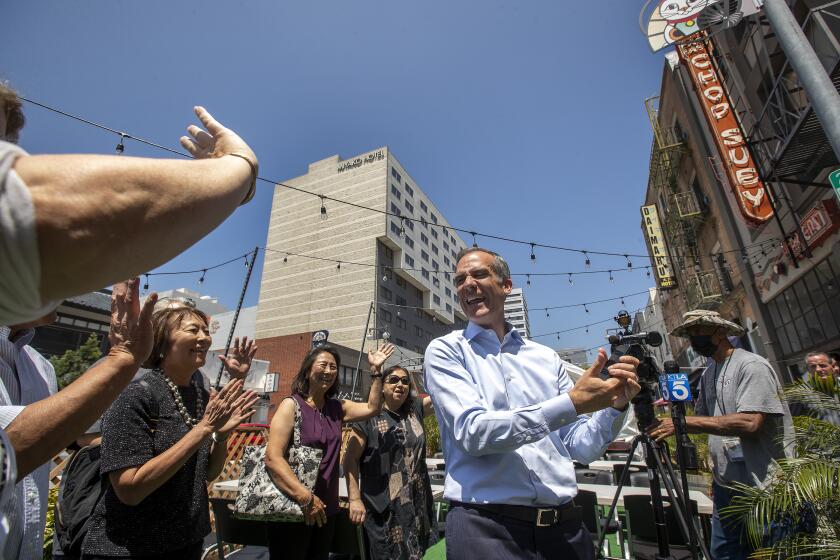California’s jobs recovery is starting to lose steam. Here are the numbers

- Share via
For months, California has added jobs at breakneck speed as it pulls out of the pandemic recession. In June, that pace clearly slowed. This month, the spread of a coronavirus variant is adding to concerns about the recovery ahead.
After four consecutive months in which each added more than 100,000 jobs, June’s gain was 73,500, state officials reported Friday. By comparison, California typically added between 15,000 and 25,000 jobs each month before the onset of the pandemic in spring 2020.
The state’s jobless rate stayed flat in June at 7.7%, as an expansion of the labor force offset job gains. (The state Employment Development Department revised the May unemployment figure to 7.7% from 7.9%.)
The problem has shifted from a weakness in worker demand to one of supply.
— Economist Lynn Reaser
The latest numbers still underscore the economy’s continued recovery after California dropped COVID-19 restrictions June 15.
The state had 16.42 million jobs as of June. Eight of 11 industry sectors added jobs last month, led by leisure and hospitality, which added 44,000. For the last five months, that has been the fastest-growing sector in the state, thanks to restaurants rehiring and tourism ramping up. It is now also the most vulnerable, as the Delta variant of the coronavirus threatens to curtail mobility.
“Unless the infection [rate] is under control, more economic pain could be ahead of us,” said Sung Won Sohn, a professor of finance and economics at Loyola Marymount University.
Economists said the recovery now hinges more on filling jobs than on creating them.
“California’s job engine made further progress in June, but the problem has shifted from a weakness in worker demand to one of supply,” said Lynn Reaser, an economist at Point Loma Nazarene University in San Diego.
In June, the number of Californians entering the job market grew for the first time in three months, signaling a pickup in hiring that was also seen across the nation. The active labor pool in California is still down more than 500,000 from before the pandemic, Reaser said. More broadly, workers seem slower to return to the job market than they have in previous recessions.
Employers in California and the U.S. are scrambling to fill jobs as the dust from the pandemic begins to settle. Just don’t call it a labor shortage.
Another factor that could put the brakes on the recovery: The emergence of the Delta variant could stymie progress, especially in leisure and hospitality jobs, which require in-person work and rely on consumers feeling comfortable enough to venture out.
“At this juncture, with the imminent expiration of extended unemployment benefits, the state cannot afford any slowdown associated with a surge in new COVID cases,” said Taner Osman, research manager at Beacon Economics and a manager at the UC Riverside School of Business Center for Economic Forecasting and Development.
Los Angeles County’s employment trends mirror those of the state. Total employment increased by 28,700 to 4,209,900. Leisure and hospitality led the gains, adding 14,300 jobs; tourism and food services made up the majority, while arts, entertainment and recreation pulled in the rest.
In June, the county had one of the highest unemployment rates statewide, at 10.6%, down from a revised 10.7% in May.
Unemployment in California fell to 7.9% in May, the fourth month state payrolls grew by more than 100,000 jobs. Still, full recovery will be slow.
Northern California continued to show some of the state’s lowest unemployment levels last month. Joblessness was at 5.4% in San Francisco County, 5.1% in Santa Clara and 5% in San Mateo. In the Southland, the unemployment rate was 8% in San Bernardino County, 7.9% in Riverside County and 6.4% in Orange County.
Small businesses continued to suffer.
“The small-business numbers are not improving but only getting worse,” said Michael Bernick, a former director of the EDD and an employment attorney at Duane Morris.
According to data released this week by Opportunity Insights, a Harvard University research group, small-business revenue in California is down 43.4% since January 2020. Mom-and-pop shops, hit especially hard by slumping consumer activity and restrictions during the pandemic, also can’t compete in the tight labor market with larger companies, which can afford to offer perks and competitive wages.
“Employers who rode out the pandemic are getting desperate to find workers,” said David M. Smith, an economist at the Pepperdine Graziadio Business School.

Nancy Wheatley, manager of Bahia Marine Inc., a sailboat rigging and marine hardware store in Huntington Beach, has been struggling to fill an entry-level job since April. The position is for an assistant to a master rigger — someone mechanically minded who can help a boat specialist, no experience necessary.
“Normally it’s not hard to get people to walk through the door with an application,” said Wheatley, who typically fills these jobs in a couple of weeks. Her son Ben, the company’s master rigger, has had to work alone in the meantime.
More than three months into her search, Wheatley is still looking to fill the job: “It’s exceptionally hard lately.”
Indeed, workers are taking their time looking for jobs, unusual in a recovering economy.
Many who were laid off during the pandemic are hoping to find something better than what they had before. “With so many companies struggling to find workers, it appears that many potential candidates may be taking longer to assess different job possibilities rather than accepting the first offer,” Reaser said. “The difficulty in recruiting workers now represents California’s most important barrier to unlocking its full economic potential.”
Mayor Eric Garcetti is tweaking L.A.’s Al Fresco dining program, which city officials may make permanent in the fall. Changes include better sidewalk accessibility.
Brianna Lauren Pomo, a bartender and server for about eight years, was laid off in March 2020 from a French restaurant in Avila Beach in San Luis Obispo County. She has been collecting unemployment and is trying to figure out her next steps — but she said she knows for sure that she won’t return to restaurant work. “You work your ass off for nothing,” she said, “and you just have to accept that.”
For years, Pomo said, she worked under abusive bosses for low pay despite having a college degree, and she took her layoff as a wake-up call. She has since become a member of ROC United, an advocacy group for restaurant workers, and has been selling her artwork.
Like many others, Pomo isn’t getting back to work right away. She plans to look for a job — a more stable one, with benefits — in the next few months. She loves spending time outdoors and has considered applying to work for the Parks and Recreation Department. “Looking forward, it’s scary,” she said. “Yet my goals are to create stability for myself.”
Smith, the economist, said even resistant workers will eventually find their way back into the job market, though it might take a while. “Workers on the sidelines can’t ignore signing bonuses, flexible hours and higher wages for much longer,” he said.
Most economists expect hiring to continue to ramp up, especially in a few months, when schools reopen after the summer break and parents may reconsider joining the workforce. “The allure of a long-term job at a high wage will draw even the most reluctant back into the job market,” Smith said.
More to Read
Inside the business of entertainment
The Wide Shot brings you news, analysis and insights on everything from streaming wars to production — and what it all means for the future.
You may occasionally receive promotional content from the Los Angeles Times.














